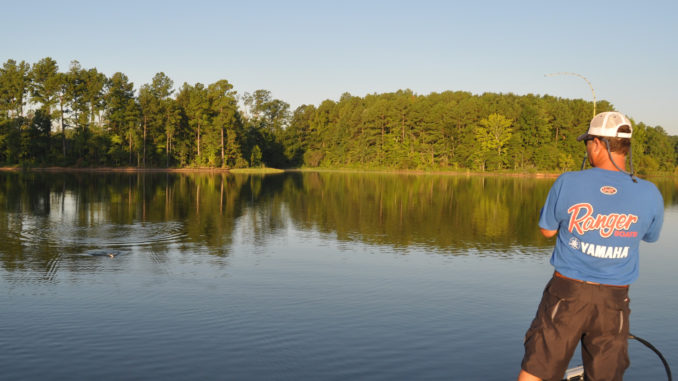
Veteran guide said mid-summer topwater fishing can be excellent, a big surprise
Many bass fishermen consider July and August times when they’re forced to spend all day in a bass boat on an open lake with no shade in the blazing sun, slathered by sunscreen, cranking deep-diving crankbaits and hoping to reach 20-foot depths where they believe big fish may be hiding. Fortunately, there’s a better way that’s much cooler and more fun.
“Everyone thinks bass go deep to find more oxygenated water and baitfish, but that’s not necessarily true every day, all the time, no matter how hot it gets,” said Jeff Thomas, a Broadway guide who fishes the three major lakes around the Raleigh-Durham area: Falls of Neuse, Shearon Harris and Jordan.
The two necessities for Thomas to catch bass on days when temperatures often peak in the 90s and the heat index climbs past 100 are the ability to get up well before dawn and a good supply of medium-to-small topwater lures.
“I want to get to a lake well before daylight, because the water temperature usually drops a little overnight,” Thomas said. “I have some favorite coves where bass school on top at daylight and for a few hours until the sun hits the water. You can catch 20 to 30 most mornings, and sometimes more than that, if we’re at the right place with Pop-Rs, small buzzbaits, and Zara Spook Juniors tied onto 7-foot reels with baitcasting or spinning reels and 10-pound line. Then you can get out of there before it gets too hot.”
Most schooling bass will be small to medium sizes, from 2 to 3 ½ pounds, but an occasional 4- to 5-pounder may show up. But it’s an odd feeling to race a bass boat in the darkness toward a designated spot, cut the throttle, coast to a stop and sit on a fishing seat with a rod and reel in hand and just watch, with your head on a 360-degree swivel.
“What you want to see are splashes as bass attack schools of tiny shad at the surface,” said Thomas (919-770-4654). “If you can cast your lure into the swirling water, you’ll get bit nine times out of 10.”
The threadfin shad must be young-of-the-year, Thomas figures, because they’re tiny: from 1 to 1 ½ inches in length.
“They’re not normally at the surface, but bass corral them up and force them to the top like sailfish,” he said. “That’s why there’ll be explosions all around you for 30 seconds or so, then it’ll stop. Then the bass will go deep again and ball up those shad while you’re waiting. Sometimes it takes five minutes, sometimes 10 minutes, then they’ll chase those baitfish to the top again.”
The action may last for a hour or longer, if it’s a cloudy day. Thomas also picks coves that are protected from the wind and without too much wave action. It’s easier to see feeding bass at such places.
“You can fish any lake you like in the piedmont that has bass and shad,” Thomas said. “It takes some time to figure out where to fish. I talk to other anglers to see if they’ve found schoolies, or I might go to a lake the previous evening and cruise around until I see evidence of bass feeding or catch some bass at a certain spot. Then I’ll be back there the next morning at dawn to have some fun with small topwater lures.”
After Thomas and his clients have had their fill, usually by 9 a.m., it’ll be time to trailer the boat before they get cooked like anglers still deep-cranking.




Be the first to comment